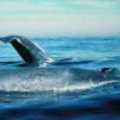|
作者:傑奇•艾倫•朱利安諾 博士
在「科學」期刊中,由19個作者共同發表的「歷史上過量的漁獵行為和近來海岸生態系統的崩潰」一文裡,他們檢視了關於從12萬5千年前即開始的人類對海岸資源剝削的資料。這樣的檢視使得他們能夠挑戰之前只根據1950年代少數研究而建立的觀念,而且那些研究也不過持續了幾年而已。
由於過去不當的研究並沒有考慮到海洋生物的生命週期,也沒考慮到歷史上曾有生命數量極其豐富的時期,因此科學教科書中的假設可能有許多漏洞。而數個世代的人們就這樣,在對人類造成環境衝擊的錯誤認知中成長。
新資料所指出的事實是全面而徹底的,並且將顛覆過去我們對於人類和自然世界互動的看法。舉例來說,之前由「國際捕鯨委員會」訂出的捕鯨限額,如今就應被視為是毫無意義,我們並且該重訂補鯨限額。日本有每年獵殺400隻鯨魚的許可,雖然他們稱這是「研究用途」,但批評者說,那只不過是商業化捕鯨的前哨罷了,因為鯨魚肉最後是被賣到日本的餐廳裡頭。還有挪威現在也還持續在捕獵鯨魚。

「法拉隆灣國家海洋禁獵區」中的藍鯨(攝影者 丹•謝皮羅,照片提供 美國國家海洋大氣總署)
歷史上,鯨魚的數目曾有上百萬,而這也是能夠確保海洋環境健康的必要數目,在今日,卻只剩下不過數十萬隻鯨魚。但東京那邊卻認為:因為鯨魚數量如此之多是很荒謬的,所以補殺鯨魚並不為過。日本漁船在獵殺了158隻鯨魚之後,最近剛從他們在西北太平洋的夏季捕獵中返航。
在美國,瀕危動物要達到從保護名單中被移除之門檻,是非常可笑地低的。例如在1994年,「美國漁類及野生物管理局」宣告灰鯨已被成功「復育」,並將其從瀕危名單中移除,他們也在1994年6月16日版的聯邦公報中,驕傲地宣稱灰鯨「已被復育」,且幾乎達到他們估計的原有數量。而在今日,野生灰鯨的數量大約是2萬1千隻。
這些用來判定「原有」物種數量的估計數字,是根據19世紀來計算的,而這個時期正是商業捕鯨開始之前。在「科學」期刊中告訴我們的新訊息可能意味著:在某一物種達到百萬數量以前,我們都不該停止保護牠們。
再一次地,我們又被提醒了,人類對生命網絡的確切範圍及對其重要性的認知,是多麼可悲地不正確。我們必須澄清原本認為物種達到某一數量即已足夠的觀念,並且嘗試去記住:地球是個複雜且活生生的有機體,生活於其中的每株植物、每隻動物、每一微生物都有其演進的理由。而某種動物的大量存在,並不代表著我們就因此握有可以獵殺牠們的執照;反而我們該將其視為一個指標,表示我們有機會讓受威脅的生態系統再度回復健全。
人類的高傲和我們自認為是最重要物種的觀念,再度地被挑戰了。事實上,我們可能是這個星球上最不重要的物種。我們幾乎沒聽說過,有哪個人對於生態系統健全的貢獻是多於他所造成的破壞的。
讓我們直截了當地一次面對吧!開始教育我們的孩子並告訴他們,人類以經濟發展之名而對地球所做的強行劫掠,已將我們帶到災禍的峭壁邊緣,而現在必須是停止的時候了。
參考資料
1. 查看2001年7月27日發行的「科學」期刊:http://www.sciencemag.org/content/
vol293/issue5530/。雖然必須先經訂閱才能在線上閱讀文章,但你可以進入他們的網站連結:http://www.sciencemag.org/feature/
data/ecology2001.shtml
2. 在綠色和平組織的協助下追蹤捕鯨行為:http://www.greenpeace.org/~oceans/whal
ing/index.html
3. 「美國魚類及野生物管理局」的瀕危動物計畫:http://endangered.fws.gov/
4. 到「海洋哺乳動物中心」認識灰鯨:http://www.tmmc.org/graywhal.htm
5. 「海上看守保育協會」嘗試阻止鯨魚的獵殺。看看他們的網站:http://www.seashepherd.org/
6. 看看許多有關美國原住民和環境的資源:http://cnie.org/NAE/index.html
7. 和「海獺之友」一起追蹤海獺議題:http://www.seaotters.org/
8.找找誰是你的國會議員代表並寄電子郵件給他們。告訴他們該是停止制訂那些只立基於世界現狀的政策的時候了;我們必須考慮生態系統在過去歷史所曾展現的內涵。如果你知道你的郵遞區號,你可以在下列的位址找到你的國會代表(本資訊針對美國公民)http://www.visi.com/juan/congress/
ziptoit.html.
傑奇•艾倫•朱利安諾博士,是住在西雅圖的一位作家和教師。他正試著想像在普吉灣裡,放眼所及到處都有鯨魚和海豹的蹤影。告訴他你的想法和計劃:jackie@healingourworld.com;請參觀他的網站:http://www.healingourworld.com
【文章連載】
■人類的傲慢和地球的衰微
(上) (下)
全文與圖片詳見:http://ens-news.com/ens/aug2001/2001L-08-10g.html
版權歸屬Environment News Service(ENS),環境資訊協會(沈怡伶 譯,高文彥、蔡麗伶 審校)
中英對照全文:http://e-info.org.tw/issue/animal/2001
/is-animal01101001.htm |
|
By Jackie Alan Giuliano, Ph.D.
The 19 authors of the "Science" article, "Historical Overfishing and the Recent Collapse of Coastal Ecosystems," examined data on the exploitation of our coastal resources that went back as far as 125,000 years. This allowed them to challenge the ideas that previously had been based on a few studies in the 1950s that had lasted only a few years.
Without taking into account the lifespans of the sea creatures and the historical abundance of life, the assumptions that have been in science textbooks since those early inadequate studies may be quite wrong. Generations of people have grown up with a poor view of what the impact of humanity has been on the environment.
The implications of this new data are sweeping and should change the way we view our interactions with the natural world. For example, quotas that have been established by the International Whaling Commission for the killing of whales must now be recognized as meaningless and be completely revised. Japan is given permission to kill 400 whales annually. They call it "research," but critics say it is just a front for commercialized whaling, since the meat is sold in Japanese restaurants. Norway also continues to hunt whales.

Blue whales in the Gulf of the Farallones National Marine Sanctuary (Photo by Dan Shapiro courtesy
NOAA)
Historically, whale populations numbered in the millions, a number that was necessary to insure the health of our oceans. Today, there are a few hundred thousand of these animals left so to suggest, as Tokyo claims, that it is acceptable to continue to hunt them because there are so many is ludicrous. Japanese ships recently returned from their summer hunt in the northwestern Pacific after killing 158 whales.
In the United States, numbers used to determine when it is OK to remove a species from the endangered list must be considered ridiculously low. For example, in 1994, the U.S. Fish and Wildlife Service declared the gray whale "recovered" and took the species off the Endangered Species List, declaring arrogantly in the June 16, 1994 edition of the Federal Register that the whale "has recovered to near its estimated original population size. Today there are about 21,000 individuals in the wild.
The estimates used to determine the "original" population numbers are from the 19th century, just before commercial whaling began. The new information in the "Science" study could mean that we shouldn't be content to cease protecting a species until it once again numbers in the millions.
Once again, we are reminded that our perception of the true extent and importance of the web of life is woefully inadequate. We must erase any notions we have of how many individuals of a species are enough and try to remember that the Earth is a complex, living organism where every plant, every animal, every microbe evolved for a reason. The presence of large numbers of an animal should not be considered license to kill it, but rather an indication that we might have a chance to restore health to a threatened ecosystem.
Human arrogance and our perception that we are the most important species has once again been challenged. In fact, we may actually be one of the least important species on the planet. How rarely we hear about a human actually contributing to the health of an ecosystem rather than its destruction.
Let's get it straight once and for all, and start teaching our children that the raping and plundering of the Earth in the name of economic growth has taken us to the brink of disaster and must stop.
RESOURCES
1. Check out the July 27, 2001 issue of "Science" at http://www.sciencemag.org/content/
vol293/issue5530/. Access to articles online is by subscription only, but you can access their web links at
http://www.sciencemag.org/
feature/data/ecology2001.shtml.
2. Keep track of whaling with the help of Greenpeace at
http://www.greenpeace.org/~oceans/whal
ing/index.html.
3. The U.S. Fish and Wildlife Service endangered species program is at
http://endangered.fws.gov/.
4. Learn about the gray whale from the Marine Mammal Center at
http://www.tmmc.org/graywhal.htm.
5. The Sea Shepherd Conservation Society tries to stop whale hunts. See them at
http://www.seashepherd.org/.
6. See many resources on Native Americans and the environment at
http://cnie.org/NAE/index.html.
7. Track sea otter issues with Friends of the Sea Otter at
http://www.seaotters.org/.
8. Find out who your Congressional representatives are and e-mail them. Tell them it is time to stop making policy based solely on the current state of the world. We must consider the historical content of ecosystems. If you know your Zip code, you can find them at
http://www.visi.com/juan/congress/
ziptoit.html.
Jackie Alan Giuliano, Ph.D. is a writer and teacher in Seattle. trying to imagine how Puget Sound must have appeared with whales and seals everywhere you looked. Please send your thoughts, comments, and visions to him at
jackie@healingourworld.com and visit his web site at
http://www.healingourworld.com
http://ens-news.com/ens/aug2001/2001L-08-10g.html |
